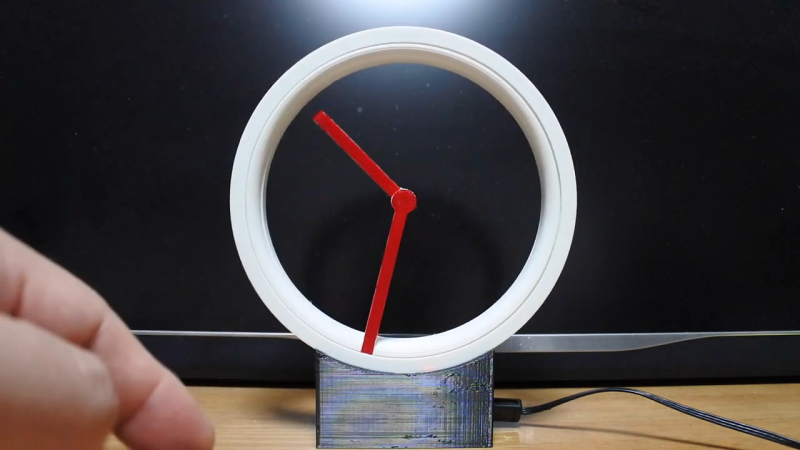We love projects that make you do a double-take when you first see them. It’s always fun to think you see one thing, but then slowly realize everything is not quite what you expected. And this faceless analog clock is very much one of those projects.
When we first saw [Shinsaku Hiura]’s “Hollow Clock 4,” we assumed the trick to making it look like the hands were floating in space would rely on the judicious use of clear acrylic. But no, this clock is truly faceless — you could easily stick a finger from front to back. The illusion is achieved by connecting the minute hand to the rim of the clock, and rotating the whole outer circumference through a compact 3D printed gear train. It’s a very clever mechanism, and it’s clear that it took a lot of work to optimize everything so that the whole look of the clock is sleek and modern.
But what about the hour hand? That’s just connected to the end of the minute hand at the center of the clock’s virtual face, so how does that work? As it is with most things that appear to be magical, the answer is magnets. The outer rim of the clock actually has another ring, this one containing a pair of neodymium magnets. They attract another magnet located in the very end of the hour hand, dragging it along as the hour ring rotates. The video below shows off the secrets, and it gives you some idea of how much work went into this clock.
We’re used to seeing unique and fun timepieces and other gadgets from [Shinsaku Hiura] — this up-flipping clock comes to mind, as does this custom RPN calculator — but this project is clearly a step beyond.
















That is so subtle its extremely charming.
Looks great, a fun and neat idea that doesn’t feel the need to attach neon signs pointing out its ‘impossible coolness’, Magic.
you sure that isn’t the Second Hand? Bit fast for a minute hand.
It’s obviously running faster than normal for demo purposes.
It and rather obvious the clock is sped up for the demonstration.
Clever use of a spur gear and worm gear with 12:1 ratio to drive both rings with a single motor in a very compact base.
You have discovered the secret as to why the Japanese are so productive.
Their clocks run faster, so they work harder and smarter to keep up!
B^)
cool design, I really love the magnets “holding” the minute hand.
great…just what I need, another project I want to do but will never get around to ;-)
There is another variant that uses hanging gears and gravity: https://youtu.be/KlNrHJdLIxs
Interesting remake of the Jefferson Golden Hour clock that was made from 1949 to 1984. That clock had a small weight and gears at the center of the dial that drove the hour hand while the minute hand was driven by a gear at the circumference of the round glass face. See: http://roger-russell.com/jeffers/jefhour.htm
My dad had this clock…
“Faceless Clock Makes YOUr Think Twice About How It Works”
but a paycheck will not make a HAD writer think twice about using spellcheck before submitting.
Good job. Spell check wouldn’t have caught that. Now YOU try writing an article. (I’m not the author btw.)
Thanks for the heads up, you’re so thoughtful.
i wanted it to have some sort of axle/chain/belt running through the minute hand to drive the hour hand :)
Former “Hollow Clock 3” is an implementation of such sort of idea,
https://www.youtube.com/watch?v=XCOC2zNjWCg
hahah you’re crazy! thanks
Did you try to make a Clock 3 drive in Clock 4 but it the hand diameter was to small or did you just decide you’d conquered that and want to make a faceless clock in a whole new way? Either way you have some skills.
Both. Recently I bought CNC and am planning to make a wooden hollow clock. The size of the work of CNC is limited, so I should design smaller version of hollow clock. In principle, hollow clock 3 is easy to make when it is large, and contrary, 4 should be small because the distance of magnetic attractive force is limited.
I look forward to seeing the wooden clock.
Wooden version
https://www.youtube.com/watch?v=1O0ks_vsLko
Yeah, me too. Of necessity the hour hand is too long and could be hard to distinguish it from a distance. A mechanical drive through the minute hand seems like a way to yield interesting results. Maybe a belt would work?
Please take a look at the former project “Hollow Clock 3” posted just above..
I’ve really enjoyed watching the development of this concept from V1 though V4. Great work, shiura!